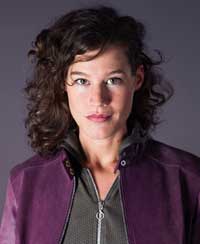 Oh! yes, Agnes Meyer-Brandis is very beautiful. She’s also bright, talented and from what i gathered from the interview i made of her, she’s a really nice person. Well… who said life was fair?
Oh! yes, Agnes Meyer-Brandis is very beautiful. She’s also bright, talented and from what i gathered from the interview i made of her, she’s a really nice person. Well… who said life was fair?
I discovered her work by chance while clicking from a festival website to another. I was a bit puzzled to be honest. Elfs? Vertical Breezometer? Mobile borehole? In February things got a bit clearer when i saw one of her installations, SGM-Iceberg-Probe, which won an award at Transmediale.
Meyer-Brandis’ background is both in science and art. Her work combines pure science and creativity to explore the zone between fact and fiction, fantasy and technology. Her current focus is on “fantasticâ€? augmented reality and other participatory urban interventions.
She also holds a teaching position at the university of applied sciences Düsseldorf, is frequently lecturing at other universities and conferences and seems to tour the world to receive awards. She is the founder of the “Forschunsgfloss / Research Raft for Subterranean Reefologyâ€?, a small institute whose chief aim is to explore and confirm subterranean phenomena.
What is your background?
I was born in 1973 and currently live and work in Cologne, Germany. I began my studies with a year in mineralogy at the University of Aachen. Then I transferred to the Art Academy in Maastricht, Netherlands to study sculpture and to the Art Academy in Düsseldorf, where I completed my Meisterschülerin (or: master apprenticeship) under Prof. Magdalena Jetelová. Subsequently, I attended the Art Academy of Media Arts [KHM], in Cologne, Germany where I completed 2 years of postgraduate studies. I received my masters diploma in audio visual media. As you can see, my academic feet are planted in both places: the traditional arts and the new media arts. Since 2003, I have been working as an independent artist.
How would you describe your art to someone for whom art equals paintings or sculptures?
For the past several years I have focused on the exploration of hidden and parallel subterranean spaces and phenomena, particularly as they occur in subterranean coral reefs.
I develop exploration tools/devices for my installations, for example SGM-Iceberg-Probe or Core-Sample Scanner, which then enable interactive participation by the viewing public. With the help of these instruments and within the context of the exhibition, the visitor is able to perform a type of field test exploration into these hidden worlds.
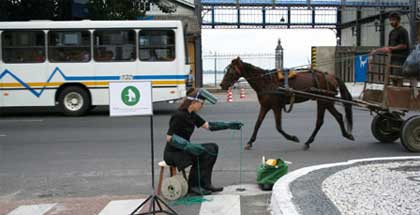 Field Test Porto Alegre of SGM-Iceberg-Probe
Field Test Porto Alegre of SGM-Iceberg-Probe
The specifically designed instruments „serve as sensitive extensions of our sensory organs“ * and permit deep migration through unknown strata and depth layers. My aim is to combine real and fictitious elements through the use of scientific methods, artistic fantasy and “ground breaking technologies”.
I am interested in the investigation of everyday life and it’s realities through the use of augmented “fantastic” reality applications.
The visitor can actually “dive” into the installation. For example, at the instant the visitor begins to search with the Coral-Reef-Detector he/she becomes part of, and in fact, completes the installation.
My installations provide a unique experience in which we can confront commonly known realities and beliefs, and put them into question through an intense sensory experience. My art is situational and subjective, everyone decides for themselves, what he/she wants to believe, even if it is only for a very short moment.
* (Siegfried Zielinski, catalogue extract: CyberArts 2003, Prix Ars Electronica 2003)
Where does your interest for the hidden come from?
To answer this question I would have to stand up and jiggle my toes… I have always been passionately interested in what lies beneath my feet. I have always asked the question: What am I truly standing on?
What is your working process? do you make a lot of preliminary research about, say, the everyday life of an elf, or the physics behind icebergs? do you work alone or with a team?
Usually I begin with a hypothetical assumption, based on my interest and curiosity. Then I jump into the adventure. At first there is a lot investigative research. I’m interested in encircling my themes, which is to say, that I like to approach themes from as many angles as possible to arrive at a multifaceted perspective. In order to achieve this I interact and exchange ideas with many specialists such as: hydro- geologists, geophysicists, mineralogists, speleologists(cave explorers), biologists and artists, etc… with similar research focus. I am interested in what motivates their research and their methods and I like to take part in their field research in order to accumulate my own experience.
The background work behind the installations, everything that happens before I even get started in transforming my installation ideas into reality, is as exciting to me as seeing the final product. Unfortunately, it’s not possible to visualize all of my research activities and adventures in each installation. But I believe that these preliminary research activities and experiences enhance the quality and subsequent perception of the installation by the viewer.
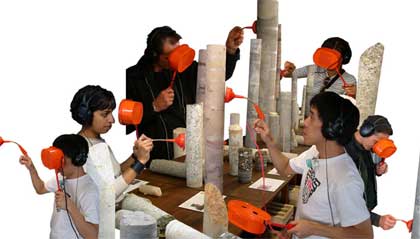 Earth-Core-laboratory and Elf-Scan
Earth-Core-laboratory and Elf-Scan
For example during my preparations for Earth-Core-laboratory and Elf-Scan I travelled to several drilling locations. I journeyed in an elevator, down a salt mine in Borth, Germany, to a depth of 700 hundred meters in order to retrieve my core samples.
Another research project involved an excursion to the research station of the University of Tübingen in southern Germany. Before I knew it, I found myself up at 6AM birdwatching with ornithologists and biologists. In the end, I received a certificate in evolution biology.
I was thrilled to receive an invitation to work and exhibit in Porto Alegre, Brazil this year (Goethe Institute POA). I visited the research station Pro-Mata, Rio Grande du Sol, a wonderful forest region. I was asked to give a presentation of my work to an audience of natural scientists from different areas. Of course, it was very exciting for me to hear their reaction to my artistic interpretation of reality. Some very enlightening discussions followed, about the different manners of approaching the unknown and the necessity of imagination to do so.
When I talk about elves, I mean to imply a sense of the unknown or indefinable. The word “elf� is only a term created by humans. Who or what these creatures really are, is not truly known.
The elves we discovered with our Core Sample Scanner demonstrated familiar patterns of subterranean behaviour…such as: an enormous tunnelling capability to control soil aeration, nutrient transport, nutrient recycling into a format utilized by plants, regeneration and decomposition of organic substances, mineralisation, gorging actions, etc. even activities that contribute to a general sense of well being. I am only able to make these comparisons and draw these conclusions because I previously studied the organic and inorganic properties of soil , as well as their interaction with the resident organisms.
I could tell a lot of stories about the many amusing and strange things I have experienced.
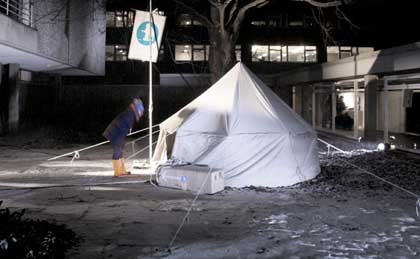 SGM-Iceberg-Probe
SGM-Iceberg-Probe
In the framework of my research for the project SGM-Iceberg-Probe I studied possible subterranean deposits of ice in Germany. I came across a fossil ice wedge in Berlin, took a look at soil properties and behaviours as influenced by temperature, etc…. and concluded that the SGM-Iceberg-Probe would be a “fantasticâ€? enterprise.
Cologne is currently building a new underground metro. As a “Specialist for the subterranean� I became the official artistic photographer for the metro construction. I find myself thus tramping, dressed in a helmet and high boots, through the tunnels.
During an informal meeting about the construction progress I heard about huge subterranean ice spheres used to stabilize the building foundation… an artificial glaciation of the soil. My enterprise suddenly took on a new twist… it was possible to find a subterranean ice sphere right in front of my own door. Of course this required immediate further investigation.
Another area of interest for me has been a study done by the AWI (Alfred Wegener Institute for polar and marine research) on “singing” icebergs. Or the recent conversations I had with with Dr. Behar, a Space Scientist and Robotics specialist at NASA / JPL Institute in California. Dr. Behar was most receptive to my many questions. His support of my efforts to develop the SGM-Iceberg-Probe were invaluable.
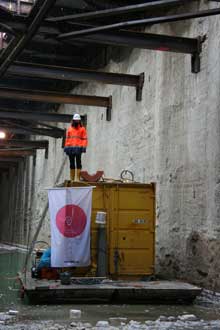
There are many more layers and creatures of the earth to discover. The exchange with others is very important to me and I am thrilled to be able to collaborate with other scientists.
A brochure published in german in 2003, is available describing the research raft, ffUR, and its research goals, methods and ethics.
In order to pursue our research goals effectively and to design and develop tools which really function well, I work together with specialists. Depending on the project and its research focus I gather a team together. At this point I would like to express my sincere appreciation to all the wonderful specialists who contributed to the realisation of, what must have at times seemed impossible, and the instruments of the researchraft. Detailed credits are listed on my website: www.ffur.de or www.researchraft.net
I find the design of your scanners and tools extremely beautiful. How important is the design to convey the experience?
First of all, thank you!
While developing and designing the tools I try to bring research ethics, function and sensory perception under one umbrella. For example, the Elf-Scanner: such as not to frighten the sensitive creatures the tool is kept very small and fits on the tip of your finger. It operates in a non-invasive way.
It is important to me that the careful exploration for collecting „sensory data“ (ears eyes nose skin) is as unobtrusive as possible; non-contact or at most micro-invasive. The probes have been designed so that they are easy and intuitive to use and enable the user a quick access to the work i.e. full immersion in these hidden worlds/unknown parallel spaces.
How does the audience react to your work? Do all age groups enjoy it the same way? is everyone ready to play?
Audience reaction has been astonishingly positive – regardless of age, educational background or social origin. I present my work not only in the strictly artistic context of a gallery or museum but also in open air public spaces, such as pedestrian zones.
I have observed how some visitors have disappeared into my installation tent for over half an hour. It is a nice coexistence; outside, in the pedestrian zone, everyday life is sweeping by and inside the tent time is holding still for a moment.
I love watching and hearing the spectator’s reactions and comments. Here is an example of the typical sequence of reactions I get from viewers at the borehole as they dive into the depths with the“Iceberg-Probe“:
phase 1) interested observation
phase 2) quizzical expression
phase 3) the begining of a smile
phase 4) eyes begin to pop
phase 5) happy glow spreads across the face
phase 6) complete open-mouthed absorption
Of course I can’t tell where each visitor’s search ends up…there are those that like to travel all over the place, those who are just playing and others who find themselves completely immersed, their feet begin to tingle and they experience a real feeling of „vertigo“.
Once I overheard a curator saying, while standing next to the earth-core laboratory and observing some elf-scan explorers: “Ah, there it is again, that famous smile of discovery“.
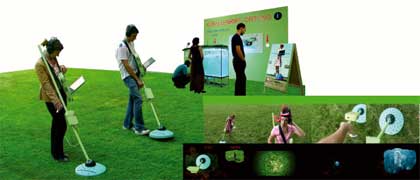 Coral-Reef-Detector
Coral-Reef-Detector
How do you support the financing of your project?
Apart from my own limited resources , I’m very grateful to have received financial support from the KHM [Academy of Media Arts in Cologne] and from the Kunststiftung NRW (North Rhine-Westphalia) in the form of project specific grants.
Depending on the project and research focus, I also apply to other research facilities and institutions. For example, I recently became the owner of my own core sample archive (thanks to the support of the NRW (North Rhine-Westphalia). The project „SGM-Iceberg-Probe“ was supported by JPL/NASA. It’s not easy to ask for financial support but it is a common necessity, especially to help cover some of the basic costs like paying a programmer. You can always put more funds to greater use…
If I had more financial resources, the tools might be even smaller and more precise or perhaps bigger and better.
At the moment, I have a couple of projects ready for take-off but awaiting financing. There can be quite a time lag between conception and realization of my installations … it doesn’t really matter if it takes 1 or 3 years.
What are you working on now?
Currently, I’m experimenting with different kinds of probes and probing directions and zones. I recently travelled to Brazil to do further field research and am in the process of preparing for two new projects. I am in the middle of a lot of investigative research.
I am pursuing a new assumption … my research focus moves to a higher level – from the underground layers to the probing of layers of hidden reality above-ground. The new focus moves from the depths to diversity and open structures.
I would prefer not to give away too many details about this new venture, but in due time, I hope to enchant you with the real installation.
Can you name me a few artists from Germany who should get more attention from the public?
Of course all my friends!!! (alphabethical order):
Ralf Baecker, Ursula and Georg Graw Böckler, Kerstin Ergenzinger, Gunnar Friel + Anja Vormann, Tobias Grewenig, Anja Kempe, Yunchul Kim, Roman Kirschner, Tamara Lorenz, Luis Negron van Grieken and Yuan Orozco.
Thanks Agnès!
Agnes Meyer-Brandis is showing Earth-Core Laboratory and Elf-Scan this month at the Interface and Society exhibition, November 10-19th, at UKS/Atelier Nord and Henie Onstad Kunstsenter in Oslo (Norway.)
